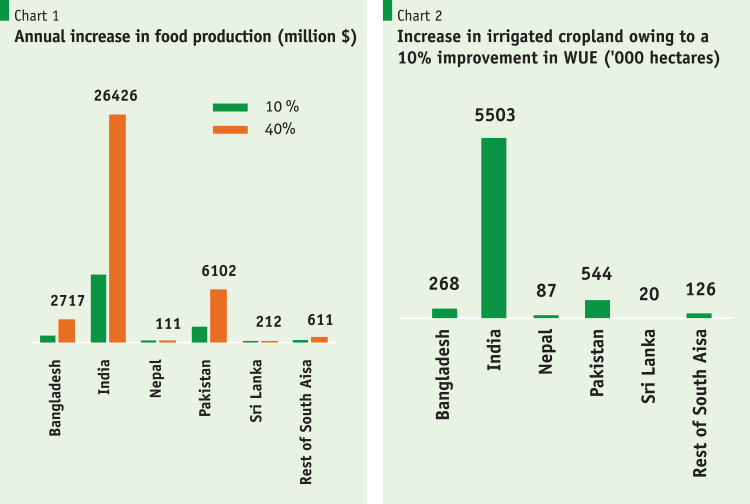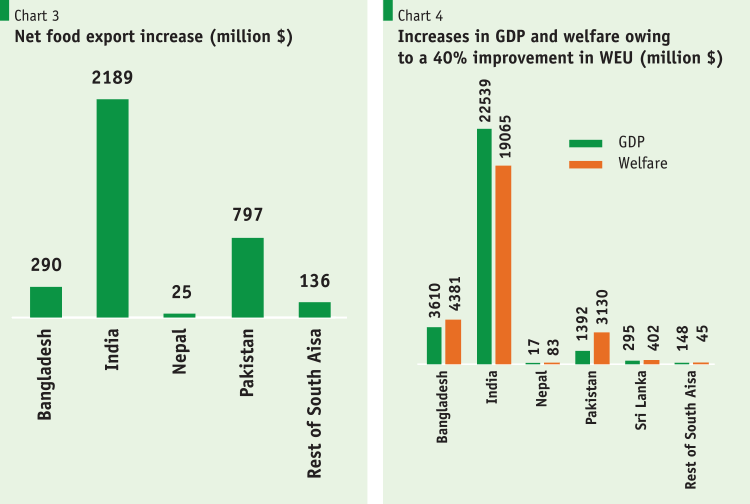Economic Impact of Water Use Efficiency Improvements in South Asia
By
Background
It is widely perceived that the South Asian economies could face a major water crisis in the coming decades. Population growth coupled with rapid economic expansion will significantly raise demand for water, particularly in irrigation, where water use efficiency (WUE) is very low. There is much greater scope for irrigation efficiency: studies have found that potential gains from WUE would be much higher for South Asia than for the South-East Asian region.
The share of agriculture in gross domestic product (GDP) of South Asian countries is relatively large (15% in Bangladesh, 19% in India, 32% in Nepal, 12% in Pakistan, 21% in Sri Lanka). Crop production in these countries relies heavily on irrigation, with the gap between actual and potential crop yields quite high. Any yield improvement could help use of water and land resources more efficiently by increasing the ‘crop per drop’ of water.
There are two ways to increase WUE in irrigation: 1) improvements in the delivery of irrigation water to the crop and 2) improvements in the utilisation of water by the plant. The gap between irrigated and rain-fed crop yields helps explain the variations in the regional impacts of WUE on crop outputs. The gain in crop production depends on the difference between the irrigated and rain-fed crop yields. If the difference is large, crop production can grow significantly. This article summarises the findings of an academic paper published in the Journal of Environmental Protection, by Farzad Taheripour, Thomas Hertel, Badri Narayanan, Sebnem Sahin, Anil Markandya and Bijon Kumer Mitra in 2016, titled ‘Economic and land use impact of improving water use efficiency in irrigation in South Asia’.
Analysing the impact of improved water use efficiency
Using an advanced computable general equilibrium (CGE) model linked to biophysical data on land and water resources, the abovementioned paper aims to find out the impact of improvements in WUE. The analytical framework used in the paper is an extension of the Global Trade Analysis Project (GTAP) Environment model (known as GTAP-E), which allows substitution among energy inputs. Water conservation in the model can be achieved via the substitution of labour, capital and energy for water consumption as well as by introducing an exogenous shock in WUE. It assumes energy and capital are substitutable inputs in economic activities, except for primary energy sectors such as gas, coal and oil.
In a series of modifications, land by agro-ecological zone (AEZ), biofuels and biofuels by-products were introduced in this model to make it suitable for studying the economic and environmental impacts of biofuel production and policies. The new model has been labelled GTAP-BIO and is widely used to examine the consequences of biofuel production at the global scale. More recently, it has been modified to track supplies of, and demand for, land and water resources within a country at a spatial resolution of a river basin by AEZ level at the global scale and to take into account competition for water across its alternative uses. The model developed as a result of this set of modifications is nicknamed GTAP-BIO-W. This allows for an examination of the extent to which enhanced WUE can increase food production in South Asia, and how it alters demand for irrigated land and affects land use. By studying several alternative scenarios to cover a wide range of WUE rates in irrigation, it is possible to offer insights into the relative costs and benefits of improved water efficiency in South Asia.
Results
The results show that a 40% improvement in WUE decreases the share of rain-fed wheat in total wheat production by 7.8% in Bangladesh, 2.7% in India, 1.5% in Nepal, 1.7% in Pakistan, 4% in Sri Lanka and 19.2% in the rest of South Asia.
Food production goes up significantly in South Asia even with just a 10% improvement in water efficiency. Estimated food production would increase annually by $739 million (1.4%) in Bangladesh, $7,887 million (1.2%) in India, $46 million (0.6%) in Nepal, $1,847 million (1.3%) in Pakistan, $81 million (0.3%) in Sri Lanka and $214 million (2.2%) in the rest of the world at 2011 constant prices. With an enhanced improvement rate of 40%, the corresponding figures would grow to $2,717 million (5%), $26,426 million (4%), $111 million (1.4%), $6,102 million (4.4%), $212 million (0.9%) and $611 million (6.3), respectively (Chart 1). 
A 10% percent improvement in WUE increases the areas of irrigated cropland by 3.9% (268,000 ha), 7.3% (5,503,000 ha), 5.9% (87,000 ha), 3.1% (544,000 ha), 2.3% (20,000 ha) and 7% (126,000 ha) in Bangladesh, India, Nepal, Pakistan, Sri Lanka and the rest of South Asia (Chart 2).
The expansion in food production owing to improvements in WUE increases the net exports of food products from South Asia. With a 10% improvement in WUE, the net exports of food products of Bangladesh, India, Nepal, Pakistan and the rest of South Asia will increase by $290 million, $2,189 million, $25 million, $797 million and $136 million at 2011 constant prices, respectively. The corresponding figures with a 40% improvement in WUE will be about $1,017 million, $7,242 million, $59 million, $2,784 million and $368 million, respectively (Chart 3). 
A 10% improvement in WUE increases the real GDPs of Bangladesh, India, Nepal, Pakistan, Sri Lanka and the rest of South Asia by 1.1%, 0.5% 0.2%, 0.6%, 0.2% and 0.5%, respectively. The corresponding annual monetary value of these increases are $1.2 billion for Bangladesh, $8.7 billion for India, $0.034 billion for Nepal, $1.16 billion for Pakistan, $0.146 billion for Sri Lanka and $0.1 billion for the rest of South Asia. An improvement in WUE in irrigation enhances GDP through several channels: 1) it extends crop production, which boosts agricultural output; and 2) it releases some water and this allows non-agriculture sectors to grow as well. The overall welfare impacts in general are different from the GDP impacts. From the consumers’ points of view, the monetary value of improvements in WUE is higher than the gains in GDP in Bangladesh, Pakistan and Sri Lanka and the reverse is true in India, Nepal and the rest of South Asia.
Policy implications
The positive impacts of improvements in WUE on food production plus its potential to lower food prices would jointly contribute to improving food security in South Asia. Policy-makers dealing with the agriculture sector and irrigation are aware of the benefits of improvements in WUE. What they have thus far lacked are quantitative estimates of the broader benefits to the economy as a whole from such improvements. This gap in knowledge is now being addressed in recent studies utilising advanced and state-of-the-art empirical techniques. However, there are questions as to how to finance improvements in WUE, given the limited public resources available. The kind of analytical models explained above make it possible for us to consider various policy choices for financing such a programme in a way that the net benefits of investment are positive. For informed policy-making, this analytical approach can be extremely helpful.





